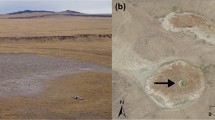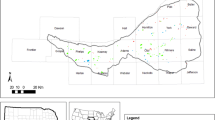Abstract
Playa wetlands provide functions critical to the existence of life on the High Plains portion of the Great Plains, including surface drainage, aquifer recharge, and wildlife habitat. These small, circular, isolated depressional wetlands with closed watersheds have a dynamic, unpredictable hydroperiod, which is essential to the maintenance of biodiversity. Most numerous in the Southern High Plains of northwestern Texas and eastern New Mexico, playas have been impacted by sedimentation, pit excavation, road construction, industrial and municipal wastewater, feedlot runoff, urban development, overgrazing, and deliberate filling. Despite being declared, as a wetland class, jurisdictional “waters of the United States” since 1977, regulations and laws for conservation of wetland functions have seldom been applied to playas. The January 2001 Supreme Court decision, Solid Waste Agency of Northern Cook County (SWANCC) v. United States Army of Corps of Engineers, likely eliminated federal regulation of impacts covered by the Clean Water Act in all but a few playas. Although still subject to the Federal “Swampbuster” provision enacted by the 1985 Food Security Act, extended natural dry periods allows for frequent cultivation and other activities in playas without incurring violation, contributing to the continued degradation of playa functions. None of the states with significant numbers of playas have regulations for the conservation of playa functions. Suggestions for the successful future conservation of playas and their associated functions include (1) increased promotion and implementation of existing federal and state conservation programs specifically for playas; (2) proposed state regulations for playa conservation; (3) recognition of agricultural impacts on wetland determinations; (4) creation of Wetland Management Districts to preserve intact, functioning playas; and (5) increased public education on the value of playas.
Similar content being viewed by others
Literature Cited
Anderson, A. M. and D. A. Haukos. 1997. Geographical distribution of amphibians on the panhandle, Southern High Plains, and Rolling Plains of Texas. U.S. Fish and Wildlife Service. Lubbock, TX, USA.
Anderson, A. M., D. A. Haukos, and J. T. Anderson. 1999. Habitat use by anurans emerging and breeding in playa wetlands. Wildlife Society Bulletin 27:759–769.
Anderson, J. T. 1997. Invertebrate communities in vegetated playa wetlands. Ph.D. Dissertation. Texas Tech University, Lubbock, TX, USA.
Anderson, J. T. and L. M. Smith. 2002. The effect of flooding regimes on decomposition of Polygonum pensylvanicum in playa wetlands (Southern Great Plains, USA). Aquatic Botany 29:1–12.
Barrows, D. B. 1981. Corps of Engineers authority and responsibility on. p. 103–106. In U.S. Fish and Wildlife Service (compiler) 1979 Playa Lakes Symposium Proceedings. U.S. Fish and Wildlife Service, Office of Biological Services, Washington, DC, USA. FWS/OBS.-81/07.
Beldon, M. 1998. Oklahoma’s contribution to the eight state panel. p. 130–134. In L. L. Triplett (ed.) The Great Plains Symposium 1998: The Ogallala Aquifer. The Great Plains Foundation, Overland Park, KS, USA.
Berthelsen, P. S. and L. M. Smith. 1995. Nongame bird nesting on CRP lands in the Texas Southern High Plains. Journal of Soil and Water Conservation 50:672–675.
Bolen, E. G., L. M. Smith, and H. L. Schramm, Jr. 1989. Playa lakes: prairie wetlands of the Southern High Plains. BioScience 39:615–623.
Conway, W. C. 2001. Breeding ecology of shorebirds in the Playa Lakes Region of Texas. Ph.D. Dissertation. Texas Tech University, Lubbock, TX, USA.
Davis, C. A. and L. M. Smith. 1998. Ecology and management of migrant shorebirds in the Playa Lakes Region of Texas. Wildlife Mongraphs 140:1–45.
Dennehy, K. F., D. W. Litke, and P. B. McMahon. 2002. The High Plains Aquifer, USA: groundwater development and sustainability. p. 99–119. In K. Hiscock, M. O. Rivett, and R. M. Davison (eds.) Sustainable Groundwater Development. Geological Society, London, Special Publication 193, London, England.
Gray, M. J. 2002. Effect of anthropogenic disturbance and landscape structure on body size, demographics, and chaotic dynamics of Southern High Plains amphibians. Ph.D. Dissertation. Texas Tech University, Lubbock, TX, USA.
Gustavson, T. C., V. T. Holliday, and S. D. Hovorka. 1995. Origin and development of playa basins, sources of recharge to the Ogallala aquifer, Southern High Plains, Texas and New Mexico. Bureau of Economic Geology, University of Texas, Austin, TX, USA. Report of Investigations No. 229.
Guthery, F. S. and F. C. Bryant. 1982. Status of playas in the Southern Great Plains. Wildlife Society Bulletin 10:309–317.
Guthery, F. S., F. C. Bryant, B. Kramer, A. Stoecker, and M. Dvorack. 1981. Playa assessment study. U. S. Water and Power Resources Service, Southwest Region, Amarillo, TX, USA.
Guthery, F. S., J. M. Pates, and F. A. Stormer. 1982. Characterization of playas of the north-central Llano Estacado in Texas. Transactions of the North American Wildlife and Natural Resources Conference 47:516–527.
Hall, D. L., M. R. Willig, D. L. Moorhead, and T. R. Mollhagen. 1995. Variation in playa lakes: Islands of diversity in a seas of agriculture and aridity. Bulletin of the North American Benthological Society 12:221.
Hall, D. L., R. W. Sites, E. B. Fish, T. R. Mollhagen, D. L. Moorhead, and M. R. Willig. 1999. p. 635–665. In D. P. Batzer, R. B. Rader, and S. A. Wissinger (ed.) Invertebrates in Freshwater Wetlands of North America: Ecology and Management. John Wiley & Sons, Inc., New York, NY, USA.
Haukos, D. A. 1994. Management of playa wetlands impacted by agriculture. p. 110–113. In Proceedings VI: Issues and Technology in the Management of Impacted Wildlife, Thorne Ecological Institute, Boulder, CO, USA.
Haukos, D. A. 2001. Analyses of selected mid-winter waterfowl survey data (1955–2001): Region 2 (Central Flyway portion). Regional Migratory Bird Office, U. S. Fish and Wildlife Service, Albuquerque, NM, USA.
Haukos, D. A. and L. M. Smith. 1993. Seed-bank composition and predictive ability of field vegetation in playa lakes. Wetlands 13: 32–40.
Haukos, D. A. and L. M. Smith. 1994. The importance of playa wetlands to biodiversity of the Southern High Plains. Landscape and Urban Planning 28:83–98.
Haukos, D. A. and L. M. Smith. 1997. Common flora of the playa lakes. Texas Tech University Press, Lubbock, TX, USA.
Haukos, D. A. and L. M. Smith. 2001. Temporal emergence patterns from seed banks of playa lakes. Wetlands 21:274–280.
Hoaglund, B. W. and S. L. Collins. 1997. Heterogeneity in shortgrass prairie vegetation: the role of playa lakes. Journal of Vegetation Science 8:277–286.
Huntzinger, T. L.. 1998. Kansas’ contribution to the eight state panel. p. 121–125. In L. L. Triplett (ed.) The Great Plains Symposium 1998: The Ogallala Aquifer. The Great Plains Foundation, Overland Park, KS, USA.
Irwin, R. J., P. J. Connor, D. Baker, S. Dodson, and C. D. Littlefield. 1996. Playa lakes of the Texas High Plains: a contaminants survey & assessment of biological integrity. Ecological Services Field Office, U. S. Fish and Wildlife Service, Arlington, TX, USA.
Iverson, C., P. A. Vohs, and T. C. Tacha. 1985. Distribution and abundance of sandhill cranes wintering in western Texas. Journal of Wildlife Management 49:250–255.
LaGrange, T. G. 1997. Guide to Nebraska’s wetlands and their conservation needs. Nebraska Game and Parks Commission, Lincoln, NE, USA.
Litke, D. W. 2001. Historical water-quality for the High Plains regional ground-water study area in Colorado, Kansas, Nebraska, New Mexico, Oklahoma, South Dakota, Texas, and Wyoming, 1930–98. National Water Quality Assessment Program. U.S. Geological Survey Water Resources Investigations Report 00-4254.
Llano Estacado Regional Water Planning Group. 2001. Llano Estacado Regional Water Planning Area: Regional Water Plan. Texas Water Development Board, Austin, TX, USA.
Luo, H. R., L. M. Smith, B. L. Allen, and D. A Haukos. 1997. Effects of sedimentation on playa wetland volume. Ecological Applications 7:247–252.
Luo, H. R., L. M. Smith, D. A. Haukos, and B. L. Allen. 1999. Sources of recently deposited sediments in playa wetlands. Wetlands 19:176–181.
MacRae, R.. 1997. A contaminant survey of playas in eastern New Mexico receiving wastewater treatment plant effluent, 1992–1993. Ecological Services Field Office, U. S. Fish and Wildlife Service, Albuquerque, NM, USA.
Mitch, W. J. and J. G. Gosselink. 2000. Wetlands, third edition. Van Nostrand Reinhold, New York, NY, USA.
Motts, W. S. (ed.). 1970. Geology and Hydrology of Selected Playas in Western United States. Air Force Cambridge Research Laboratories and Geology Department, University of Massachusetts, Amherst, MA, USA.
National Research Council. 1995. Wetlands Characteristics and Boundaries. National Academy Press, Washington, DC, USA.
Osterkamp, W. R. and W. W. Wood. 1987. Playa-lake basins on the Southern High Plains of Texas and New Mexico: part I hydrologic, geomorphic, and geologic evidence for their development. Geological Society of America Bulletin 99:215–223.
Petrie, M., J. Rochon, G. Tori, R. Pederson, and T. Moorman. 2001. The SWANCC decision: implications for wetlands and waterfowl. Ducks Unlimited, Inc., Memphis, TN, USA.
Reeves, C. C., Jr. and J. A. Reeves. 1996. The Ogallala Aquifer (of the Southern High Plains). Estacado Books, Lubbock, TX, USA.
Rosen, M. R. 1994. The importance of groundwater in playas: a review of playa classifications and the sedimentology and hydrology of playas. p. 1–18. In M. R. Rosen (ed.) Paleoclimate and Basin Evaluation of Playa Systems. Geological Society of America Special Paper 289.
Scribner, K. T. and R. J. Warren. 1990. Seasonal demography and movements of cottontail rabbits on west Texas playa basins. Journal of Wildlife Management 54:403–409.
Scribner, K. T., J. H. Dowell, and R. J. Warren. 1989. Spatial genetic variability among introduced populations of the ring-necked pheasant. Southwestern Naturalist 34:27–34.
Seyffert, K. D.. 2001. Birds of the Texas Panhandle. Texas A & M University Press. College Station, TX, USA.
Smith, L. M.. 2003. Playas of the Great Plains. University of Texas Press, Austin, TX, USA.
Smith, L. M. and D. A. Haukos. 2002. Floral diversity in relation to playa wetland area and disturbance. Conservation Biology 16:964–974.
Steiert, J. 1998. The value of water to environmental interests: wildlife. p. 75–84. In L. L. Triplett (editor) The Great Plains Symposium 1998: The Ogallala Aquifer. The Great Plains Foundation, Overland Park, KS, USA.
Sweeten, J. M.. 1994. Water quality associated with playa basins receivign feedlot runoff. p. 161–173. In L. V. Urban and A. W. Wyatt (Compilers) Proceedings of the Playa Basin Symposium. Water Resources Center, Texas Tech University, Lubbock, TX, USA.
Thurman, E. M., K. C. Bastian, and T. Mollhagan. 2000. Occurrence of cotton herbicides and insecticides in playa lakes of the High Plains of West Texas. Science of the Total Environment 248: 189–200.
Willig, M. R., D. L. Hall, D. L. Moorhead, T. R. Mollhagen, and E. B. Fish. 1995. Variation in water quality among playa lakes: a multivariate approach and landscape perspective. Bulletin of the Ecological Society of America Supplement 76:285.
Wyatt, A. W. and D. D. Smith. 1981. Legal status of playa basins and playa water. p. 99–102. In U.S. Fish and Wildlife Service (compiler) 1979 Playa Lakes Symposium Proceedings. U.S. Fish and Wildlife Service, Office of Biological Services, Washington, DC, USA. FWS/OBS-81/07.
Zartman, R. E., R. H. Ramsey, P.W. Evans, G. Koenig, C. Truby, and L. Kamara. 1996. Outerbasin, annulus and playa basin infiltration studies. Texas Journal of Agriculture and Natural Resources 9:23–32.
Author information
Authors and Affiliations
Rights and permissions
About this article
Cite this article
Haukos, D.A., Smith, L.M. Past and future impacts of wetland regulations on playa ecology in the southern great plains. Wetlands 23, 577–589 (2003). https://doi.org/10.1672/0277-5212(2003)023[0577:PAFIOW]2.0.CO;2
Received:
Revised:
Accepted:
Issue Date:
DOI: https://doi.org/10.1672/0277-5212(2003)023[0577:PAFIOW]2.0.CO;2




